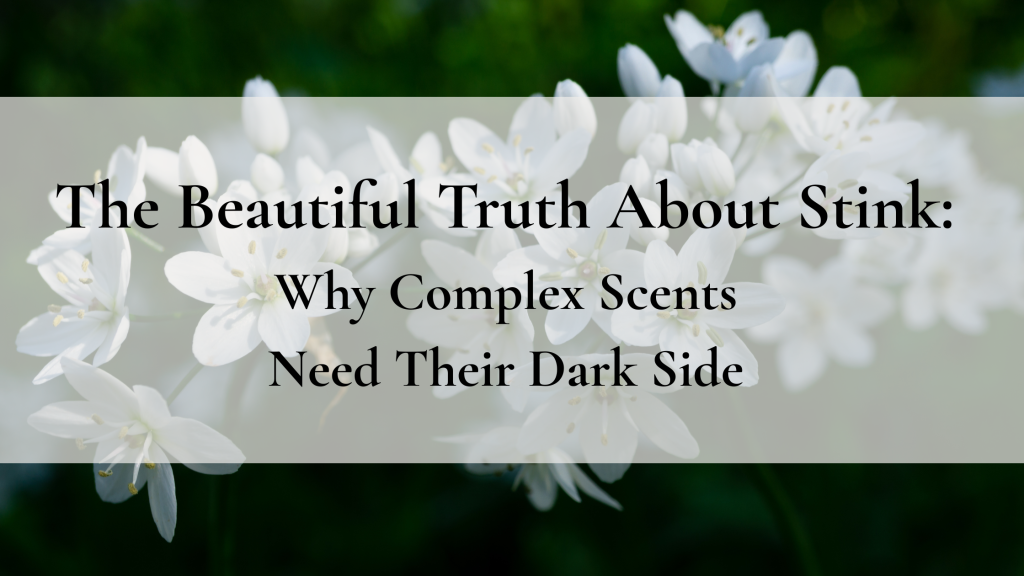The Beautiful Truth About Stink

Why Complex Scents Need Their Dark Side
Here’s a confession that might surprise you: some of the world’s most beloved and expensive fragrances contain ingredients that, in isolation, smell absolutely terrible. We’re talking about notes that would make you wrinkle your nose, step back, or even gag if you encountered them alone. Yet these “stinky” elements are not mistakes or contaminants, they’re essential building blocks that create the complexity, depth, and addictive quality that makes certain scents unforgettable.
Welcome to the paradoxical world of perfumery, where beauty often emerges from the marriage of light and dark, sweet and funky, pleasant and… well, not so pleasant.
The “Stink” Hall of Fame
Before we dive into why this works, let’s acknowledge some of the most notorious offenders that have earned their place in the fragrance world:
Ambergris: This waxy substance from sperm whale digestive systems is prized in high-end perfumery despite its initial fecal odor. When aged and properly diluted, it becomes warm, sweet, and marine-like, the ultimate fixative that makes fragrances last for hours.
Civet: Secreted by the anal glands of civet cats, this musky paste smells intensely animalic and fecal in its pure form. Yet it’s been treasured for centuries as a base note that adds warmth and sensuality to fragrances.
Natural Musk: Originally derived from the scent glands of male musk deer, pure musk is described as powerfully animalic, sweaty, and sometimes urine-like. In dilution, it becomes the epitome of sensual warmth.
Indole: Found naturally in jasmine and orange blossom, this compound smells like mothballs and feces in high concentrations. But in tiny amounts, it’s what gives these beloved florals their intoxicating, narcotic quality.
Skatole: Another compound that smells exactly like what you’d expect from something found in feces, yet it’s also present in white flowers and contributes to their heady, intoxicating character.
The Science of Scent Complexity
Why do these malodorous ingredients create magic when blended properly? The answer lies in how our olfactory system processes complex scent molecules and how our brains interpret contrasting information.
Contrast Creates Interest: Just as a painting needs shadows to make the light appear brighter, fragrances need darker, more challenging notes to make the beautiful elements truly shine. A purely sweet fragrance can become cloying and one-dimensional. Add a hint of something slightly off-putting, and suddenly the sweetness becomes more nuanced, more interesting, more alive.
Dilution Transforms: Many of these “stinky” ingredients undergo a complete personality change when properly diluted. Indole at 100% concentration is repulsive; at 0.01%, it makes jasmine smell like heaven. The art of perfumery lies in finding that precise tipping point where offensive becomes alluring.
Evolutionary Wiring: Some researchers suggest we’re evolutionarily programmed to find certain “stinky” scents appealing because they signal fertility, health, or genetic compatibility. That slight animalic quality might trigger deep, subconscious attraction responses.
The Appeal of “Acquired Taste” Scents
This principle extends beyond traditional perfumery into the scents that divide people in everyday life. Consider these polarizing favorites:
Cannabis/Marijuana: Often described as “skunky,” the terpenes that create this distinctive smell are the same compounds found in hops, pine, and citrus. For many, the initial off-putting quality gives way to associations with relaxation, creativity, and community.
Gasoline: The sweet, chemical complexity of gasoline appeals to many people, possibly because benzene compounds can trigger euphoric responses, but also because the scent becomes associated with power, adventure, and mechanical precision.
Truffle: These prized fungi smell like a cross between garlic, cheese, and earth, not immediately appealing to many. Yet their rarity and the complex, savory depth they add to food creates a luxury association that transforms perception.
Durian: The “king of fruits” smells like garbage to some, heaven to others. Those who love it describe layers of custard, almond, caramel, and vanilla beneath the initial sulfurous assault.
The Perfumer’s Paradox
Professional perfumers understand this paradox intuitively. Master perfumer Roja Dove once said that a great fragrance should have “a face and a body”, the face is what attracts you initially, but the body includes the more complex, sometimes challenging elements that keep you coming back.
This is why many commercial fragrances, despite smelling immediately pleasant, lack staying power in both longevity and emotional impact. They’re all “face” and no “body.” They please everyone initially but captivate no one deeply.
The most memorable fragrances, the ones that develop cult followings and inspire passionate devotion, almost always contain elements that some people will find off-putting. These challenging notes create what perfumers call “sillage” and “longevity,” but more importantly, they create emotional complexity.
Applying the Philosophy
Whether you’re developing a custom fragrance for a brand, creating a signature scent for an event, or simply trying to understand why you’re drawn to certain “weird” smells, this principle offers valuable insight:
Embrace the Tension: Don’t shy away from fragrance elements that feel slightly challenging or unexpected. That hint of leather in a floral scent, the whisper of smoke in something fresh, or the touch of animalic warmth in something clean might be exactly what elevates it from pleasant to unforgettable.
Context is Everything: A note that smells terrible in isolation might be the secret ingredient that makes everything else shine when properly balanced and diluted.
Trust the Process: Great scents, like great art, often require time to reveal their full character. What seems off-putting at first sniff might become your signature obsession once you understand its layers.
The next time you encounter a scent that makes you pause, not because it’s immediately beautiful, but because it’s complex, challenging, or intriguingly weird, take a moment to appreciate the artistry involved. Someone carefully calibrated that “stink” to create something extraordinary. And that, perhaps, is the most beautiful truth about fragrance: sometimes the most captivating scents are the ones that dare to be a little bit bad.

